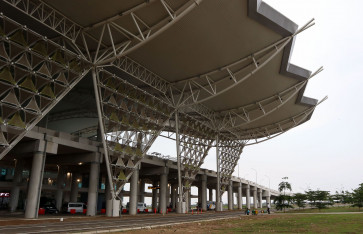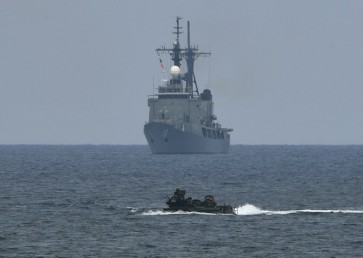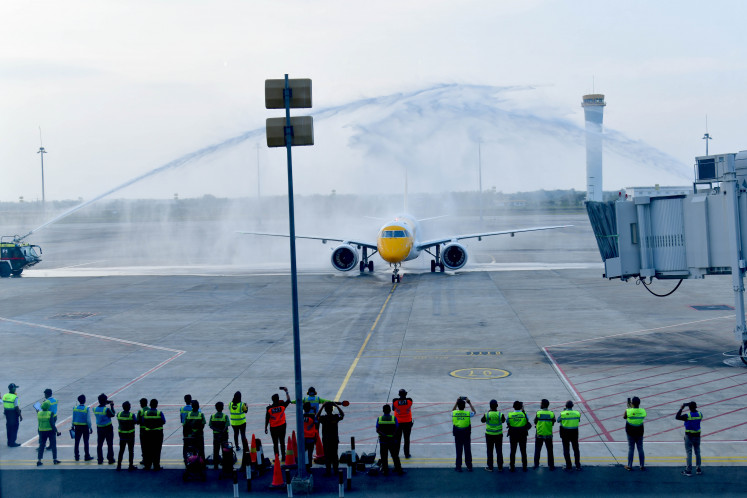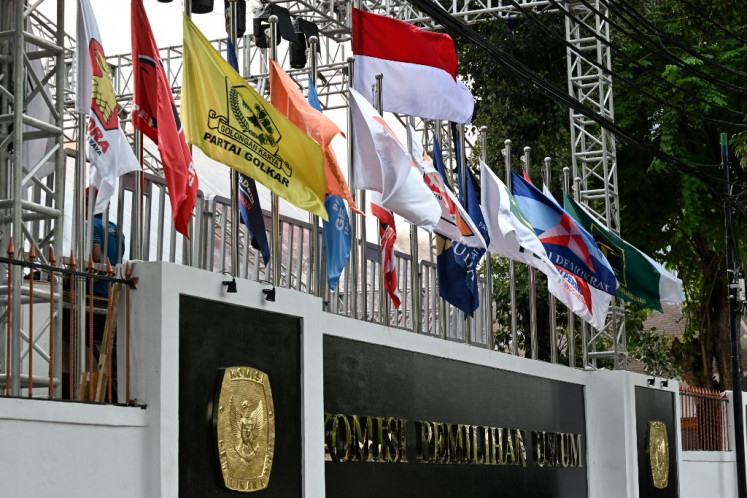Popular Reads
Top Results
Can't find what you're looking for?
View all search resultsPopular Reads
Top Results
Can't find what you're looking for?
View all search resultsArt for Sale: Good days of art collecting
Pasukan Kita Yang Dipimpin Pangeran Diponegoro (Our Soldiers Led Under Prince Diponegoro) by S
Change text size
Gift Premium Articles
to Anyone
 Pasukan Kita Yang Dipimpin Pangeran Diponegoro (Our Soldiers Led Under Prince Diponegoro) by S. Sudjojono. (Courtesy of theedgegalerie.com)" width="596" height="296">Pasukan Kita Yang Dipimpin Pangeran Diponegoro (Our Soldiers Led Under Prince Diponegoro) by S. Sudjojono. (Courtesy of theedgegalerie.com)
Pasukan Kita Yang Dipimpin Pangeran Diponegoro (Our Soldiers Led Under Prince Diponegoro) by S. Sudjojono. (Courtesy of theedgegalerie.com)" width="596" height="296">Pasukan Kita Yang Dipimpin Pangeran Diponegoro (Our Soldiers Led Under Prince Diponegoro) by S. Sudjojono. (Courtesy of theedgegalerie.com)Some see the countryâs current art market as flagging, especially when compared to the painting scene circa 2007. However, others see the current situation as a blessing, the ideal breeding ground for better art-collecting attitudes.
During the Indonesian painting boom around 2007, a growing number of works by Indonesian contemporary artists fetched higher and higher prices, exceeding the prices of those by the countryâs old masters, or established names.
The phenomenon was referred to as the âfourth painting boomâ, with its major epicenters located in the art cities of Bandung, Jakarta and Yogyakarta.
Art curator Amir Sidharta said the art market in Indonesia was still growing, though not as quickly as it had in 2007 and 2008.
âProfits in the art market have always had two dimensions â financial gain and artistic gain. Back then, it was more about financial gain, but nowadays the latter plays a larger role. Collectors now are more about the artistic and intellectual side of the activity,â he told The Jakarta Post.
âThe prices of paintings keep on increasing, but they are more stable now than when they soared during the boom. Prices are now more measured. Today, weâre better able to say how and why a painting is highly priced.â
In April, an oil painting by Indonesian master painter S. Sudjojono titled Pasukan Kita yang Dipimpin Oleh Pangeran Diponegoro (Our Soldiers Led Under Prince Diponegoro) was sold for HK$58.4 million (US$7.5 million) at Sothebyâs in Hong Kong. The 1979 painting, sized 100 centimeters (cm) x 199.5 cm, was predicted to be sold at around HK$20 million.
The auction set a new record for Sudjojonoâs work, with his previous auction record HK$10.7 million.
âThe painting was sold at close to Rp 100 billion, but the price was more or less understandable because Sudjojono is a pioneer of Indonesian art. The painting is rare and also quite large,â said Amir, who owns Sidharta Auctioneer.
Collector Maya Sujatmiko said while the Indonesian art scene was surprised by the record-breaking sales, at the same time, Indonesian contemporary artists were recording unsold rates of up to 40 percent.
âAre we having a slow time in the art market? I think we should look at it from another perspective. This could be some sort of a blessing in disguise,â Maya said in a recent discussion at the Salihara cultural center in Jakarta.
On the gallery side, she said, although exhibition numbers were decreasing, the demand for paintings continued - either for collection, decoration or gift purposes.
âOnly galleries that continue exhibiting artwork will be chosen by these people. Galleries are seeing less competitors,â said Maya, the owner of Artsphere Gallery.
Artists, she continued, also thrived in situations where they could work to their fullest without being chased, forced and influenced by market demands.
 Pasukan Kita Yang Dipimpin Pangeran Diponegoro (Our Soldiers Led Under Prince Diponegoro) by S. Sudjojono. (Courtesy of theedgegalerie.com)<)
Pasukan Kita Yang Dipimpin Pangeran Diponegoro (Our Soldiers Led Under Prince Diponegoro) by S. Sudjojono. (Courtesy of theedgegalerie.com)<)
P
span class="caption" style="width: 594px;">Pasukan Kita Yang Dipimpin Pangeran Diponegoro (Our Soldiers Led Under Prince Diponegoro) by S. Sudjojono. (Courtesy of theedgegalerie.com)
Some see the country's current art market as flagging, especially when compared to the painting scene circa 2007. However, others see the current situation as a blessing, the ideal breeding ground for better art-collecting attitudes.
During the Indonesian painting boom around 2007, a growing number of works by Indonesian contemporary artists fetched higher and higher prices, exceeding the prices of those by the country's old masters, or established names.
The phenomenon was referred to as the 'fourth painting boom', with its major epicenters located in the art cities of Bandung, Jakarta and Yogyakarta.
Art curator Amir Sidharta said the art market in Indonesia was still growing, though not as quickly as it had in 2007 and 2008.
'Profits in the art market have always had two dimensions ' financial gain and artistic gain. Back then, it was more about financial gain, but nowadays the latter plays a larger role. Collectors now are more about the artistic and intellectual side of the activity,' he told The Jakarta Post.
'The prices of paintings keep on increasing, but they are more stable now than when they soared during the boom. Prices are now more measured. Today, we're better able to say how and why a painting is highly priced.'
In April, an oil painting by Indonesian master painter S. Sudjojono titled Pasukan Kita yang Dipimpin Oleh Pangeran Diponegoro (Our Soldiers Led Under Prince Diponegoro) was sold for HK$58.4 million (US$7.5 million) at Sotheby's in Hong Kong. The 1979 painting, sized 100 centimeters (cm) x 199.5 cm, was predicted to be sold at around HK$20 million.
The auction set a new record for Sudjojono's work, with his previous auction record HK$10.7 million.
'The painting was sold at close to Rp 100 billion, but the price was more or less understandable because Sudjojono is a pioneer of Indonesian art. The painting is rare and also quite large,' said Amir, who owns Sidharta Auctioneer.
Collector Maya Sujatmiko said while the Indonesian art scene was surprised by the record-breaking sales, at the same time, Indonesian contemporary artists were recording unsold rates of up to 40 percent.
'Are we having a slow time in the art market? I think we should look at it from another perspective. This could be some sort of a blessing in disguise,' Maya said in a recent discussion at the Salihara cultural center in Jakarta.
On the gallery side, she said, although exhibition numbers were decreasing, the demand for paintings continued - either for collection, decoration or gift purposes.
'Only galleries that continue exhibiting artwork will be chosen by these people. Galleries are seeing less competitors,' said Maya, the owner of Artsphere Gallery.
Artists, she continued, also thrived in situations where they could work to their fullest without being chased, forced and influenced by market demands.
Visitors enjoy works on display during an exhibition at Bentara Budaya gallery in Jakarta. (JP/Jerry Adiguna)
'Artists can work with their hearts and as a result, produce quality artwork,' Maya said.
As investment collectors tended to feel safer putting their money into the work of old masters, art collector and observer Syakieb Sungkar noted how the tendency had pushed the price of the paintings higher than those of contemporary artists.
The old masters include the likes of Affandi, S. Sudjojono, Hendra Gunawan, Lee Man Fong, Basoeki Abdullah, Dullah and Ahmad Sadali.
'Price tags for paintings by the first four names have exceeded Rp 1 billion [US$86,000], while work from the other three are still available at a lower price,' Syakieb says.
He said the work of younger artists such as Christine Ay Tjoe, Agus Suwage, Nyoman Masriadi, Handi Wirman and Rudi Mantofani had been attractive investment items.
New collectors, he said, needed time to get to know the playing field.
'It takes around two years for newcomers to tune in to the environment: looking around, asking around and visiting exhibitions and auctions'.
Syakieb acknowledged that increasing demand and prices for the old masters' work had led to mushrooming forgeries.
'The main problem in the Indonesian art market is the absence of an authoritative institution that defines whether a painting is genuine or a forgery,' he said.
Earlier this year, the Indonesian Art Lovers Association (PPSI) ' of which Syakieb is a member ' launched a book titled Jejak Lukisan Palsu Indonesia (Tracing Fake Indonesian Paintings), which aims to provide a reference for fellow collectors to identify fake paintings, avoid buying fake work and encourages discussions to find solutions to the problem.
Maya said that in addition to a lack of a legal body, the country also needed an institution to undertake forensic investigations of questionable paintings, an art history school to produce urgently needed art historians and a good archiving system to monitor artwork.
As a collector, Syakieb said he preferred that the current scene was 'flagging' as he could take his time choosing which artwork to buy.
'Many people compare the current situation to 2007, but what happened then was an anomaly. If we keep looking back, we're not going to move forward,' he said.









